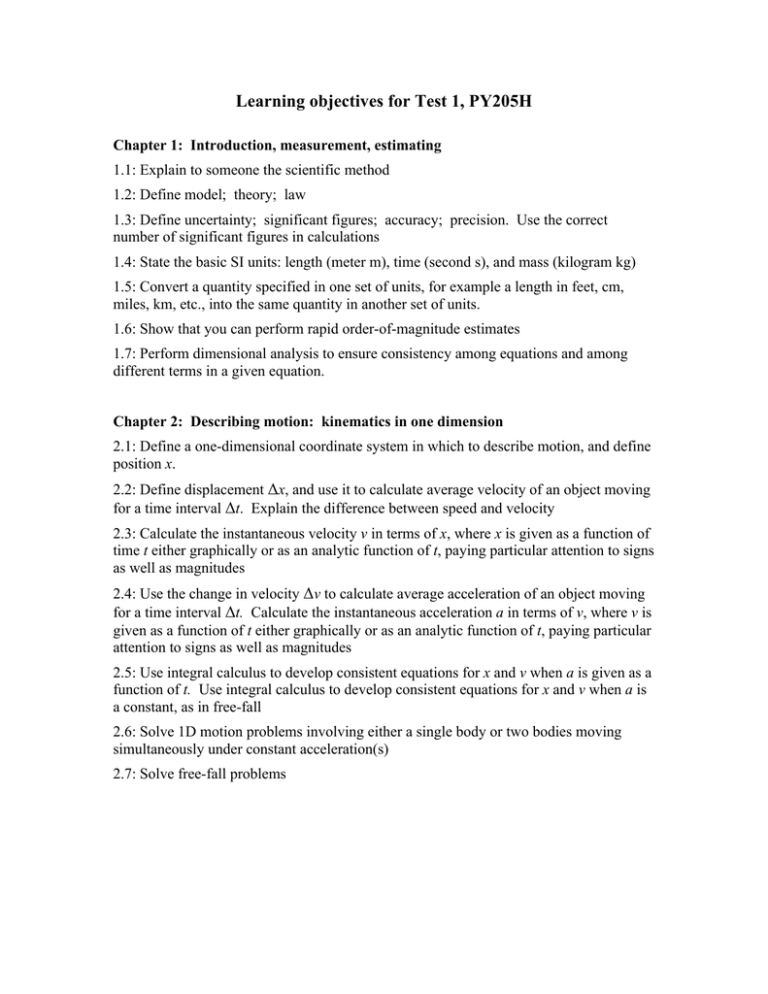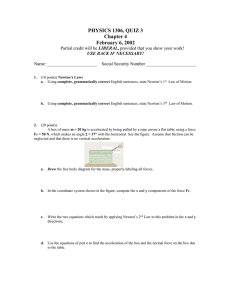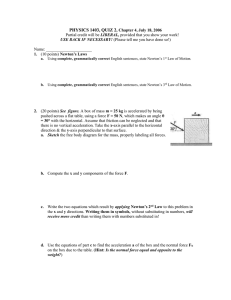Learning objectives for Test 1, PY205H
advertisement

Learning objectives for Test 1, PY205H Chapter 1: Introduction, measurement, estimating 1.1: Explain to someone the scientific method 1.2: Define model; theory; law 1.3: Define uncertainty; significant figures; accuracy; precision. Use the correct number of significant figures in calculations 1.4: State the basic SI units: length (meter m), time (second s), and mass (kilogram kg) 1.5: Convert a quantity specified in one set of units, for example a length in feet, cm, miles, km, etc., into the same quantity in another set of units. 1.6: Show that you can perform rapid order-of-magnitude estimates 1.7: Perform dimensional analysis to ensure consistency among equations and among different terms in a given equation. Chapter 2: Describing motion: kinematics in one dimension 2.1: Define a one-dimensional coordinate system in which to describe motion, and define position x. 2.2: Define displacement Δx, and use it to calculate average velocity of an object moving for a time interval Δt. Explain the difference between speed and velocity 2.3: Calculate the instantaneous velocity v in terms of x, where x is given as a function of time t either graphically or as an analytic function of t, paying particular attention to signs as well as magnitudes 2.4: Use the change in velocity Δv to calculate average acceleration of an object moving for a time interval Δt. Calculate the instantaneous acceleration a in terms of v, where v is given as a function of t either graphically or as an analytic function of t, paying particular attention to signs as well as magnitudes 2.5: Use integral calculus to develop consistent equations for x and v when a is given as a function of t. Use integral calculus to develop consistent equations for x and v when a is a constant, as in free-fall 2.6: Solve 1D motion problems involving either a single body or two bodies moving simultaneously under constant acceleration(s) 2.7: Solve free-fall problems Chapter 3: Kinematics in two or three dimensions; vectors 3.1: Explain the difference between vectors and scalars, giving examples of each 3.2, 3: Describe how to add and subtract vectors graphically. Draw diagrams illustrating the sum A + B and difference A − B of two given vectors A and B. Use the properties of a right triangle to compute the length of A + B and A − B where the directions of A and B differ by 90° 3.4: For a given coordinate system, resolve a vector A into components. Add and subtract two vectors A and B using components 3.5: Define the Cartesian unit vectors iˆ, jˆ, and kˆ, and write a given vector A in terms of them. Perform sums and differences of vectors written in unit-vector form 3.6: State and use the vectorial definitions of position, velocity, and acceleration. State and use the vectorial definitions of displacement, average velocity, and average acceleration. State and use the vectorial definitions of (instanteous) velocity and acceleration. Use calculus to develop or check results involving vectors. 3.7: Define the conditions for projectile motion 3.8: Solve problems of projectile motion 3.9: Define relative velocity. Describe motions of moving objects with respect to an observer who may or may not be moving Chapter 4: Dynamics; Newton’s Laws of Motion 4.1: Define force F, and describe its units in terms of m, kg, and s. 4.2: State Newton’s First Law of Motion; Define inertial reference frame; Give examples of objects obeying Newton’s First Law of Motion. 4.3: Define mass, and give its SI unit 4.4: State Newton’s Second Law of Motion in vector form. Write Newton’s Second Law of Motion in component form for a give coordinate system. Use Newton’s Second Law of motion to solve kinematics problems in 1, 2, and 3 dimensions 4.5: State Newton’s Third Law of Motion. For a pair of objects that are in contact, show how Newton’s Third Law applies. Give examples of Newton’s Third Law of Motion at work in everyday life 4.6: Write gravitational force near the surface of the earth as an acceleration vector g. Define contact force, normal force, and weight. Solve one-dimensional kinematics problems involving vertical motion 4.7: Given an object, draw a free-body diagram of it making sure to include all forces and accurately locating their points of application. Draw free-body diagrams of objects in one- and two-body systems involving gravitational and contact forces. Use free-body diagrams in either one or two dimensions to establish the equations of motion (Newton’s Second Law) of objects that are either stationary or undergoing acceleration. Solve the resulting equations of motion algebraically. Using a free-body diagram, show that the tension in a rope (assumed massless) is the same everywhere Solve specific configurations involving motion, for example a block sliding down an incline or two blocks connected by a string passing over a massless pulley (Atwood machine) Chapter 5: Using Newton’s Laws: friction, circular motion, drag forces 5.1: Define the coefficient of friction in both static µs and kinetic µk cases. State and use the empirical law of friction between ordinary surfaces under both static and kinetic conditions. Draw free-body diagrams of objects in one- and two-body systems involving gravitational, contact, and frictional forces. Use free-body diagrams in either one or two dimensions to establish the equations of motion (Newton’s Second Law) of objects that are either stationary or undergoing acceleration where friction is involved. Solve the resulting equations of motion algebraically. Solve specific configurations involving friction, for example a block that either cannot slide down an incline because µs is too large, or where it is actually sliding down an incline. 5.2: Describe uniform circular motion. Define centripetal acceleration, and derive the expression giving the centripetal acceleration of an object in terms of its speed v and the local radius of curvature R of its path. In a diagram of an object moving in a circle, draw the vector representing centripetal (radial) acceleration 5.3: Use free-body diagrams to establish the equations of motion (Newton’s Second Law) of objects that are undergoing centripetal acceleration. Solve the resulting equations of motion algebraically 5.4: Set up and solve problems involving motion of objects on banked curves




